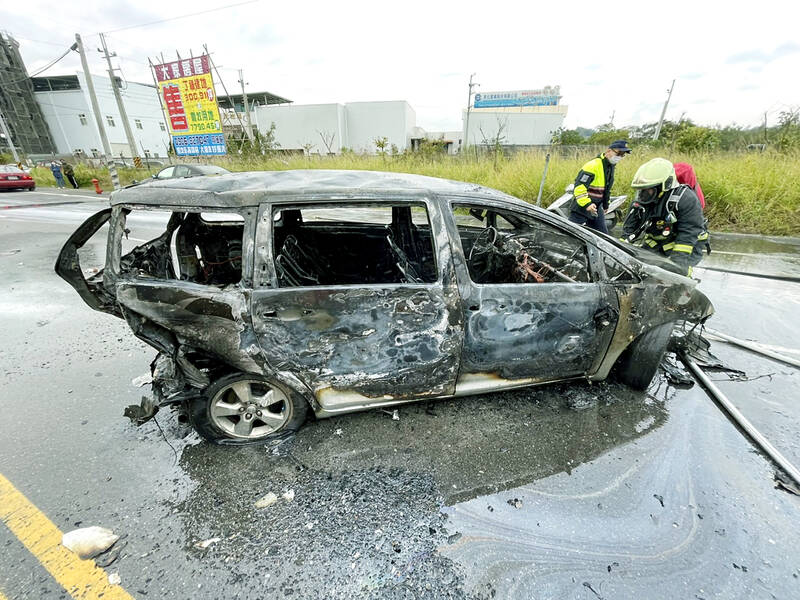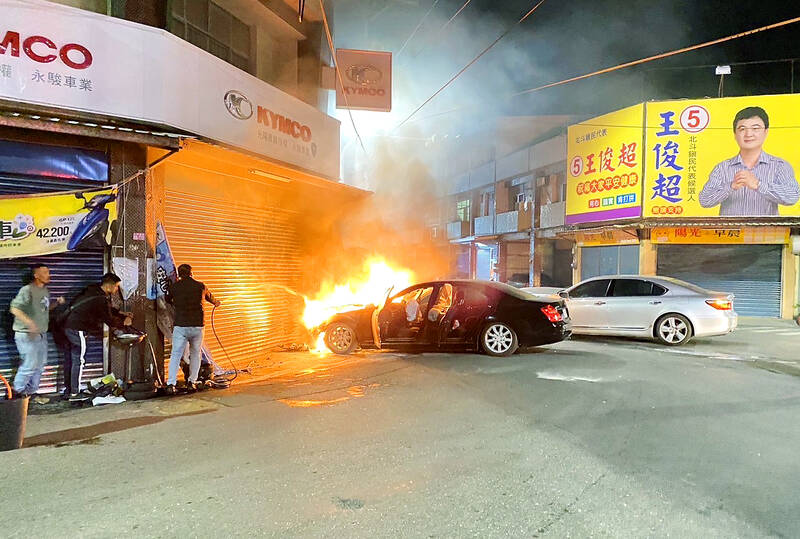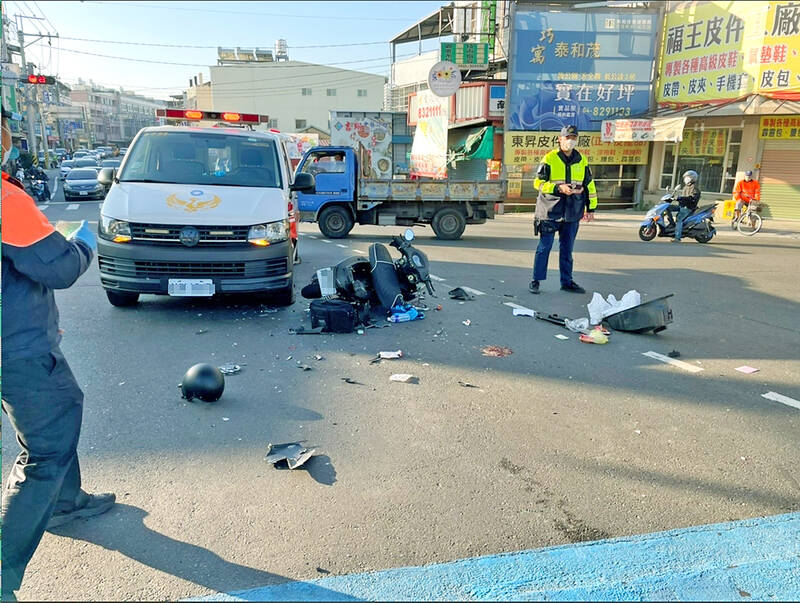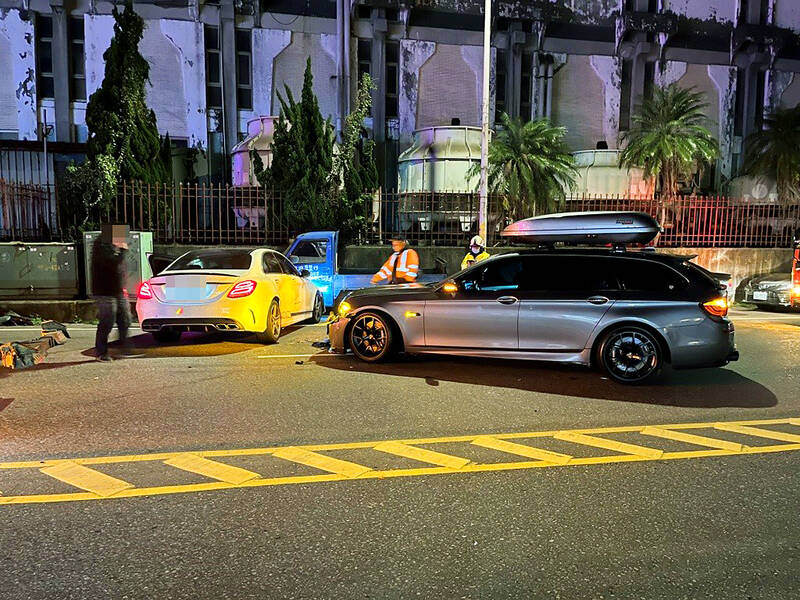Sometimes, in writing this column, I feel like a peasant who has stumbled upon the carnage of a great but failed cavalry charge: dead horses lying everywhere.
In Taiwan the dead horses still lie there year after year, asking to be beaten. Last week a bus driver in Taichung struck and killed a mother and child legally crossing at a crosswalk. This was the worst of several recent incidents involving bus drivers in the area, suggesting that the hidden factor in so many “accidents” was at play: production pressure on workers. The “human factor” is too often employer inhumanity towards workers.
Yet also at play is the dead hand of the developmentalist state. Every year we have more traffic lights as empty land is subdivided into rectangles for development, producing endless rows of intersections and straight roads that invite speeding. Eventually every intersection is given a traffic light.

Photo provided by the public
STREET PLANNING
Borough wardens have a role in this as well. When accidents occur, residents demand action, and getting a traffic light put in is a visible and easily performed response. The result is that there are always more traffic lights.
More traffic lights lead to more speeding because the lights are not timed. Drivers all understand that the only way to avoid lights is to drive as fast as possible, to get through as many as they can before they hit the inevitable red light. Or the inevitable pedestrian or scooter.

Photo provided by the public
Nobody ever asks for roundabouts, though they are well known to be safer. After all, they would take up a tiny bit of space developers want to wring profits from. Can’t have that! Nor does anyone suggest closing city centers to traffic, though Taiwan’s cramped city centers are ideal for it. As for reducing speed limits, who would pay attention? There’s always another light to beat.
It’s almost as if someone planned the road system to result in as many accidents as possible. Right on cue after the bus accident, the government reported last week that road fatalities had risen over 6 percent to over 2,500 in the first 10 months of last year, rising again as they have every year since 2019. Sad, because for many years traffic deaths had been falling.
The government blamed the rising accident and death rates on “the high number of scooter-related accidents,” the Central News Agency (CNA) reported. The reader must be shocked to learn that the lowest class of drivers takes the blame. Given that there are over 14 million scooters against around 8 million cars in Taiwan, they will inevitably be involved in the lion’s share of accidents.

Photo provided by the public
Meanwhile, despite their ubiquity, scooter drivers face unprotected lanes shared with cyclists, and have to deal with the constant hazards of roadside vendors, taxis and rideshare operators pulling over, and the bane of everyone who uses the curbside lanes, illegally parked cars. Road and parking priority goes to cars, the least efficient transportation tool.
It’s hardly surprising that scooters are heavily involved in accidents: study after study shows that smaller objects on the road such as scooters, bicycles and pedestrians are routinely unseen by drivers of larger vehicles, even when in plain sight, a phenomenon known to researchers as “inattentional blindness,” as the Taichung bus tragedy last week illustrates.
ELECTION ISSUE?

Photo: Lee Jung-ping, Taipei Times
Election season is right around the corner, with the nation moving toward the next year’s national elections. The pro-China Chinese Nationalist Party (KMT) is going to be looking for issues, and here is one that instantly suggests itself: the nation’s traffic accident situation. That issue has even received the imprimatur of the international media with the now-infamous CNN report on Taiwan’s traffic hell.
It is telling that in the two instances in which the ruling Democratic Progressive Party (DPP) has made a highly public hard call, the ractopork issue and terminating 4-month conscription service, significant foreign pressure and publicity was involved.
Lest anyone imagine that the KMT will be inhibited by the hypocrisy of criticizing the ruling DPP for moving too slowly to rectify a situation created by decades of its misrule and corruption, recall that it has accused the DPP of running an authoritarian state, engaging in “green terror,” being in bed with the mafia and so on.
A good example of this was the Taichung mayoral election in 2018. In that election, air pollution — a legacy of KMT indifference to factory emissions and vehicle pollutants, as well as Taipower’s love of fossil fuels — nevertheless became an important issue for the KMT candidate to attack the DPP incumbent mayor, who later became the Minister of Transportation and Communications.
When President Tsai Ing-wen (蔡英文) first took office, she appointed Ho Chen-tan (賀陳旦) as Minister of Transport and Communications. Ho vowed to reduce traffic fatality rates by 15 percent over the following three years. He lasted until July of 2018. A couple of months later, the train derailment at Sinma (新馬) Train Station in Yilan County occurred. The MOTC minister has changed four times since then. The nation desperately needs stability in its ministerial posts.
Train accidents, including the Taroko Express accident in 2021 that killed 49 and injured 200, dominated the headlines, but rising traffic deaths can be made to reflect poorly on the government even if they turn out to be no more than statistical noise in the long-run.
As with so many other pressing issues, the DPP has not been sufficiently proactive, one reason for its lousy election performance in November. The DPP must get out in front of this issue — one that affects everyone. Taiwanese are constantly reminded of this: traffic accidents are a staple of TV news.
It would not take much to shift the tone of reporting to something quite negative for the DPP. At the very least, this is a national issue waiting for a party to grab and run with it.
The KMT cannot be depended on to run an ardent right-wing nationalist like Hung Hsiu-chu (洪秀柱) or Han Kuo-yu (韓國瑜) whom any halfway decent DPP politician could steamroll. In Hou You-yi (侯友宜), the popular KMT mayor of New Taipei City, it has a competent politician who is Taiwanese and at the moment, ahead in most polls. Probable DPP candidates lack his experience and stature.
In July last year, some 5,000 people attended a rally held by the Formosa Motorcycle Rights Association on Taipei’s Ketagalen Boulevard. According to this paper, association spokesman Huang Po-yue (黃柏岳) said that the number of traffic fatalities “should be considered a national security crisis.”
The rally, attended by several third-party politicians, a signal of its political potential, called for lifting of “outdated restrictions and bizarre rules.”
Its theme? “Lift Martial Law on the Road,” a reminder of how old these rules and problems are.
Notes from Central Taiwan is a column written by long-term resident Michael Turton, who provides incisive commentary informed by three decades of living in and writing about his adoptive country. The views expressed here are his own.

The Taipei Times last week reported that the rising share of seniors in the population is reshaping the nation’s housing markets. According to data from the Ministry of the Interior, about 850,000 residences were occupied by elderly people in the first quarter, including 655,000 that housed only one resident. H&B Realty chief researcher Jessica Hsu (徐佳馨), quoted in the article, said that there is rising demand for elderly-friendly housing, including units with elevators, barrier-free layouts and proximity to healthcare services. Hsu and others cited in the article highlighted the changing family residential dynamics, as children no longer live with parents,

Oct 20 to Oct 26 After a day of fighting, the Japanese Army’s Second Division was resting when a curious delegation of two Scotsmen and 19 Taiwanese approached their camp. It was Oct. 20, 1895, and the troops had reached Taiye Village (太爺庄) in today’s Hunei District (湖內), Kaohsiung, just 10km away from their final target of Tainan. Led by Presbyterian missionaries Thomas Barclay and Duncan Ferguson, the group informed the Japanese that resistance leader Liu Yung-fu (劉永福) had fled to China the previous night, leaving his Black Flag Army fighters behind and the city in chaos. On behalf of the

I was 10 when I read an article in the local paper about the Air Guitar World Championships, which take place every year in my home town of Oulu, Finland. My parents had helped out at the very first contest back in 1996 — my mum gave out fliers, my dad sorted the music. Since then, national championships have been held all across the world, with the winners assembling in Oulu every summer. At the time, I asked my parents if I could compete. At first they were hesitant; the event was in a bar, and there would be a lot

The election of Cheng Li-wun (鄭麗文) as chair of the Chinese Nationalist Party (KMT) marked a triumphant return of pride in the “Chinese” in the party name. Cheng wants Taiwanese to be proud to call themselves Chinese again. The unambiguous winner was a return to the KMT ideology that formed in the early 2000s under then chairman Lien Chan (連戰) and president Ma Ying-jeou (馬英九) put into practice as far as he could, until ultimately thwarted by hundreds of thousands of protestors thronging the streets in what became known as the Sunflower movement in 2014. Cheng is an unambiguous Chinese ethnonationalist,